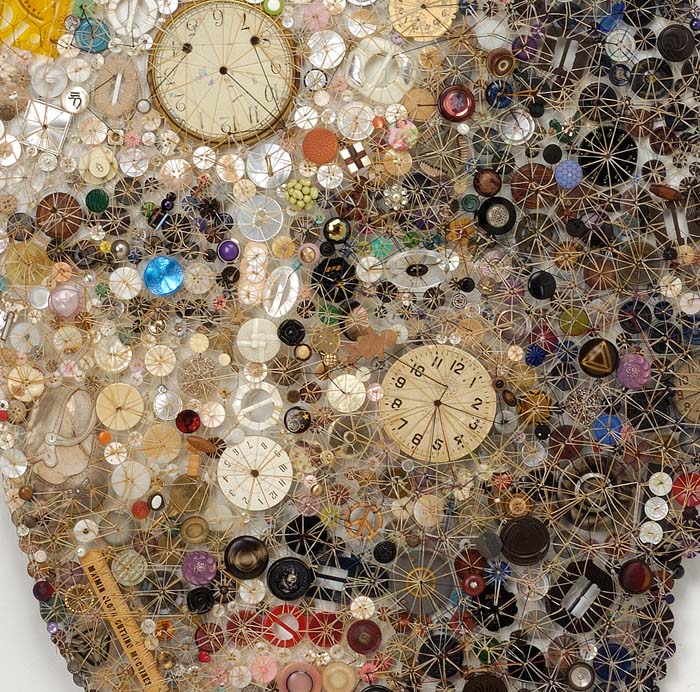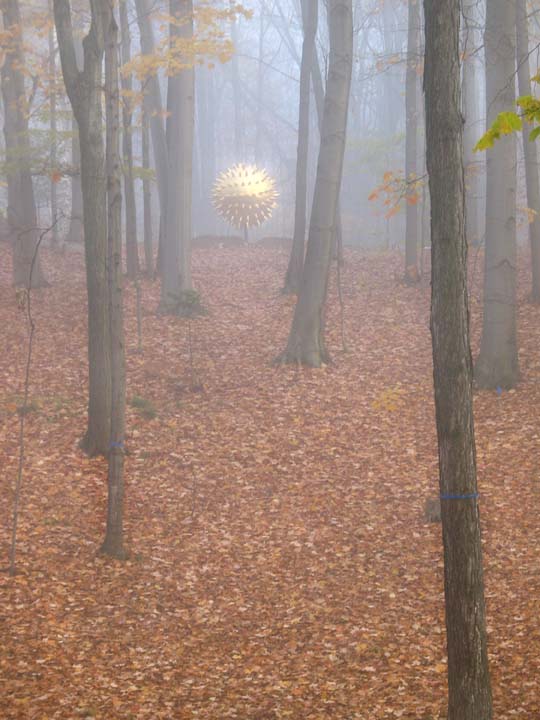Interviewsand Articles
Editor's Introduction w & c #21: Visible/Invisible
by Richard Whittaker, Jan 20, 2017

Peace Chains, Joe Murphy
As usual, our theme appeared only after a lot of material had been gathered. It’s how our themes always seem to arrive. There’s always a point where the visible and the invisible meet: Fredric Fierstein’s striking statue, Guardian, looking out across the San Francisco Bay, is a case in point. The search this figure sent me on was propelled by the visible drama of its form, as well as by hidden elements that really proved to be the more compelling. When the invisible is clearly in play it’s worth wondering whether one’s in the grip of imagination or whether something more objective is at work. It may have to remain an open question.
As I thought about the visible and the invisible, it quickly became clear it’s far too large a subject to address in even a simple way—that is, if one wished to mark out its boundaries somehow. The word “invisible” easily sends my thoughts towards the magical, the spooky or fantastic. The movie, “The Invisible Man,” comes to mind.
But with only a little more thought, one realizes our experience is full of the invisible; sound, smell and sensation are just the most obvious. But what about the question of our experience? Is experience itself visible?
Lisa Kokin’s image Muse is a beautiful evocation of the inspiration that arrives so powerfully, and always in a hidden way. Under its power artworks are made, actions initiated, projects begun—all of which then enter into the realm of the visible.
(if you step back six or eight feet, you'll see Kokin's image in a new way.)
The two words visible/invisible could almost stand as a summary of artmaking itself. In Rue Harrison’s interview with Kokin, we learn something of the underlying history that can be seen in her work.
And then there’s J. Kathleen White, whose work we’ve published before. And we always struggle to find words for its delightful and quirky essence. (Do words belong in the realm of the visible or the invisible?) Take the title of her most recent work, 21 Day-Hikes in the Umbra Region of the Vespertine. If that’s not enough, wait until you’ve spent some time with the work itself. If you’re like me, you’ll love being gently levered out of the known territory.
A chance conversation with high school teacher Cherri Farrell moved me so much I wanted to bring some of her stories to others. They exemplify some of the hidden things not covered in the curriculum, small things, one might be tempted to think. In our conversation, the art of teaching is brought to life.
We also have installment #6 of Guide, Enrique Martínez Celaya’s remarkable meditation on art and value. There’s a line in this installment that’s perfect for our theme—“To make an artwork requires measurable things like discipline, ideas and some skill, but also requires other things that come from the inside as well as from mid-air.”
Jon Gariepy’s beautiful ceramic boats and cars caught my attention and I wasted no time looking him up to see more of his work. It speaks directly. In Reader’s Forum [started in #20] we feature three artists—first, Ginger Mayerson of LA who we connected with in our Secret Alameda days. And there’s Florence Lewis, whose work caught my attention in an exhibit at the Richmond Art Center. And not long ago, Tom Deacon, a successful furniture-designer-turned-artist from Toronto, sent us the ethereal image on the inside back cover and an eloquent description of his work.
It’s gratifying to be able to give some exposure to artists such as these.
I first heard about Joe Murphy (Joe Peace) from Nipun Mehta. “You’ve got to meet this guy!” he told me. He makes these things he calls “Peace Chains” and he gives them away. Quoting Joe, each of his artworks is, “a piece of a PIECE for PEACE. Together we make A PEACE CHAIN for a peace chain-reaction.” I think you’ll find Joe’s story pretty inspiring.
And finally Rue Harrison’s Indigo Animal narrative moves one step closer to its conclusion as LSRI director, Orange Bearcat, leads honored guests and the entire student body to the Institute’s neglected classical garden.
About the Author
Richard Whittaker is the founding editor of works & conversations and West Coast editor of Parabola magazine.
SUBSCRIBE NOW
TO OUR MONTHLY NEWSLETTER









Share Your Comments and Reflections on this Conversation: